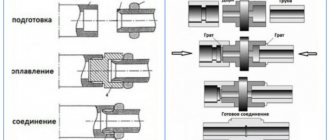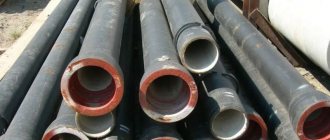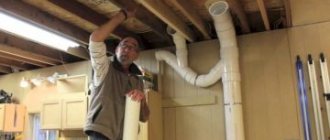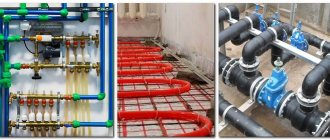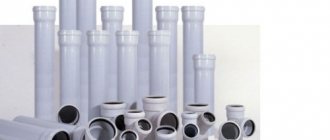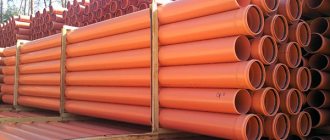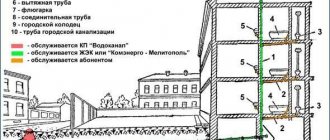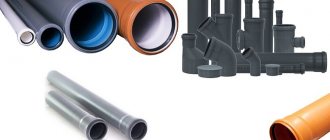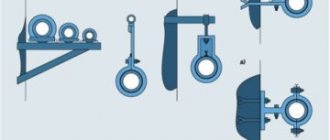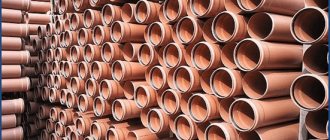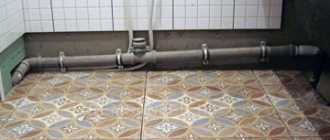Menu
Pipe service life:
- Cast iron sewer
- PVC sewer and water supply
- Ceramic
- Plastic
- Polypropylene
- Metal-plastic
- How to extend the service life of pipes made from these materials
- Video
During the construction of any facility, pipelines are installed in parallel. These necessary durable structures are made of cast iron, plastic, polypropylene, iron and other materials.
The service life of such pipes is equally influenced by the physical and chemical properties of the substances from which they are made, as well as the chemical activity of the medium transported by the pipeline.
In addition, the service life is affected by the temperature characteristics of the pipeline’s internal media, as well as the weather conditions in which the system operates.
Cast iron sewer
What is the service life of cast iron sewer pipes and what does it depend on?
According to the manufacturer's data, the service life of cast iron sewer pipes in private or apartment buildings is about 50-70 years. Although, if you use international experience, such systems can function successfully for 100 or even 200 years! Unbelievable but true!
The service life is affected by the placement conditions of the highway. It is known that sewer systems can be installed both outside and inside the apartment. In this regard, the service life of cast iron sewer pipes in the ground, for example, is significantly less than in a dry room.
Very important: the service life is significantly influenced by the quality of the connections made. The thing is that if the pipeline elements are not connected very well, then the transported medium begins to flow at the joints, which in turn contributes to an accelerated corrosion process.
In general, cast iron products can be considered the most durable of all currently known analogues from other materials. Although, according to GOST 6942-98, the warranty period is only 2 years from the moment the pipeline is put into operation.
Thus, although cast iron sewer systems are becoming increasingly rare today, they have been and remain one of the most durable. According to the results of numerous surveys, many prefer sewer pipes made of alternative materials, based on financial considerations: the cost of cast iron is too high compared, for example, with plastic.
Cleaning pipes to increase service life
Over time, sewage deposits appear on the inner surface of the pipes in the system. This is a completely natural process that occurs for a number of reasons. On the one hand, deposits that are present in sewage are deposited on the walls, and on the other, layers of rust grow on the inner surface of pipes that have been corroded. Because of this, the cross-section of the pipe may decrease. In order to avoid this, a cement-sand coating can be applied to the inner surface. This coating also protects against corrosion, since the water passing through it is enriched with alkaline elements. However, this may not always prevent clogging completely, and the pipes will still need to be cleaned.
Sewer flushing can be of several types:
- Chemical cleaning, using liquid or powdered products that, when mixed with water, break down dirt and deposits in the pipe;
- Mechanical cleaning is carried out only by specialist craftsmen when using flexible or spiral torsos. The master inserts the torso into the pipe and, as soon as it reaches the seal, it is necessary to begin to rotate it in order to destroy it completely. Cast iron pipes are not afraid of such cleanings - due to the durability of the material, when using a torso, cracks and damage do not occur on the inner surface of the pipe;
- Cleaning sewer pipes using special machines. This method is the most expensive because it requires calling out special equipment, but it guarantees complete cleaning of the pipe from blockages and deposits. The most commonly used hydrodynamic cleaning method is based on the use of water energy released under pressure to the site of deposits.
PVC sewer and water supply
When the building materials market began to fill with plastic products, the share of the use of such pipes in the construction of pipelines increased significantly. Most often, PVC pipes are used in domestic conditions when arranging apartments and private houses. With their help, heating, sewer, and ventilation lines are laid. Therefore, potential buyers always want to know the service life of plastic systems, what it depends on, and how the service life of PVC pipes can be increased.
According to manufacturers' advertisements, sewer pipes can be successfully operated for about 50 years.
Although, not everything is so simple, since this indicator is determined by several factors:
- type of plastic;
- environmental conditions;
- pressure in the system;
- temperature of the internal environment.
PVC products are different:
- safety, lack of toxicity;
- practicality when installing the highway;
- light weight;
- long service life without clogging;
- complete neutrality to corrosion and aggressive environments;
- resistance to living microorganisms.
PVC products are often used for the installation of cold and hot water supply lines, since they are able to withstand water temperatures within +90°C. A water supply system made from PVC pipes will last much longer than a sewer system. The service life of such PVC pipes will be approximately 50 years. Some experts even call the figure 100 years for the operation of PVC water pipelines.
Cast iron or steel
Those who were in the basements of Peterhof probably noticed the massive pipes that supply water to its famous fountains. This is one of the oldest cast-iron water pipelines still functioning today. It was built to last; Moreover, the builders of the royal residence, frankly speaking, did not particularly take into account the costs.
In the second half of the last century, economic feasibility came first. In fact, why build a water supply system with a service life of one and a half centuries, if in 40 years the city area will be expanded and rebuilt with the laying of new highways?
It was then that steel main water pipelines became widespread - relatively cheap and, most importantly, much more technologically advanced in terms of installation.
Advice: electric welding and external waterproofing with bitumen are carried out much faster than manual embossing and pouring the socket.
The consequences of the savings are quite predictable and are still being felt:
- The service life of a pipe laid in the ground, despite waterproofing measures, rarely exceeds 30-40 years. After this time, numerous fistulas in it make the amount of drinking water loss unacceptable.
It’s interesting: according to estimates by local authorities, in Sevastopol, the city where the author of the article lives, 40% of water is lost due to wear and tear of the water supply network.
- Moreover, the steel pipe is actively overgrown from the inside with lime deposits and rust. Over a couple of decades, the clearance can decrease by 3–4 times with a corresponding drop in pressure and patency.
This is what an old steel water pipe looks like inside.
How does cast iron look against this dull background?
- With proper quality of external waterproofing, the actual service life of a pipe laid in the ground is at least a century.
- The pipeline is practically not overgrown from the inside.
Cast iron water supply in the basements of Peterhof.
The only problem with cast iron water supply is that it is highly sensitive to ground movements: where the steel pipe is slightly deformed, the cast iron pipe will burst.
Ceramic
Even the ancient Romans used baked clay to produce ceramic pipes, from which they built systems for draining rainwater and domestic wastewater. Today, ceramic products have successfully competed with cast iron and plastic. According to research results, these materials are less durable than ceramics.
Ceramic pipes are characterized by:
- minimum roughness of the internal (working) cavity. Thanks to this quality, a high flow rate is ensured, which eliminates the possibility of retention of various types of sediment on the walls of the system;
- high mechanical strength;
- resistance to sudden temperature changes;
- chemical inertness. Thanks to a special glaze covering the internal and external surfaces, special joint designs, and sealing materials, not only abrasive wear is completely eliminated, but also the impact of alkaline and acidic environments (pH level = 0-14);
- high environmental friendliness, which is expressed in reliable protection of the contents of the sewerage system from contact with the environment.
For ceramic products, the service life has virtually no restrictions.
What affects the lifespan of a sewer?
If you want the system to last longer, you need to make sure that only high-quality materials are used during installation.
When choosing a pipe, it is important to check the following:
- The external and internal diameter of the pipes must strictly comply with the requirements established by GOST;
- There should be no unnecessary depressions or growths on the surface of the pipes;
- Pipes must be pre-treated with petroleum bitumen;
- Sometimes it is worth considering using special cast iron to protect the coating;
- Check the anti-corrosion coating. Its surface should not have repeated inclusions. Fistulas and sutures should not be visible;
- A fine-grained structure should be observed at breaks and turns.
Internal defects in pipes are much more difficult to find, but experienced craftsmen can determine the presence and location of damage by the sound of tapping the pipe with a metal object. If there are defects, the sound of the blow will differ in duration and tone from the same taps on products that do not contain defects.
Attention - elements for laying systems!
There are many different elements that are used to lay sewer lines. These are various adapters, branching crosses, plugs, fittings, etc. It must be remembered that it is not enough to choose the right pipe itself; it is important to pay special attention to the material of these elements. All materials must be compatible with cast iron. If the material is not selected correctly, the geometry of connections and pipes may change during temperature changes. The pipe material must be free of slag, sagging and foreign growths. The slightest non-compliance with the standard can lead to rapid failure of not only individual elements, but also the entire system at the initial stage of use.
Plastic
When purchasing plastic pipes, the first question that arises from the buyer may be: “What is the service life of such products, what advantages do they have?” In addition, the potential client is interested in the scope of application, the main operating and linear parameters of the pipes.
Plastic pipes differ:
- increased resistance to corrosion processes. Therefore, they are not afraid of moisture, they do not rust or rot, which is very important when using products in heating systems and water supply systems;
- environmentally friendly, since they do not contain chemically hazardous and harmful substances;
- low thermal conductivity coefficient, which contributes to long-term heat retention, which cannot be said about metal products;
- high resistance to sudden changes in temperature and pressure;
- complete absence of noise during water flow inside. Thanks to the internal smooth surface, the possibility of limescale and other mineral deposits is eliminated;
- lightness, which is very convenient for loading, transportation, installation;
- ease of installation, connections in which are made by soldering;
- external neatness and aesthetics;
- low cost, which is important for many consumers.
They are used for installation of water supply systems, sewerage systems, and horizontal wiring of heating systems.
In advertising materials you can read that plastic pipes can function at temperatures up to +95°C and a pressure of 100 kPa. The service life is 50 years or more.
Installation features
To avoid blockages along the wastewater route, pipe laying begins from the main riser in the direction of the well. Pipes should initially be taken larger than the calculated diameter - this is for safety net - in case of installing new plumbing or building a bathhouse with a swimming pool.
There are two connection options:
- Detachable when couplings or flanges are used. Tightness is ensured by rubber gaskets. The method is convenient because, if necessary, the water supply or sewerage system can be disassembled by simply removing the couplings.
- One-piece - in a socket, using welding or glue. The glue is selected depending on the materials. For polymers, this is epoxy resin.
Not all methods are available to beginners, so it is better to turn to professional workers, or choose the easiest connection method.
Advantages and disadvantages
The easiest way is to connect the pipes into a socket. It is important to place a rubber ring for tightness, and the socket itself should be directed in the direction from which the water flows. This reduces the risk of blockages. To make the pipes easily dock, use lubricant or regular detergent.
Welding is a complex method. Without skills, connecting pipes will not be easy. For non-pressure sewerage, welded seams are quite reliable.
The use of epoxy glue allows you to connect pipe parts at the molecular level. Before starting work, the joints are degreased. You need to act quickly, as the resin dries quickly in air.
The fittings are installed on O-rings to avoid leakage at the joints.
Polypropylene
Why do many people prefer polypropylene pipes?
The answer is simply simple:
- they are not affected by corrosion;
- they are chemically passive to working fluids and gases;
- are distinguished by ease of connections into a single pipeline;
- They have a huge range of locking and connecting fittings.
If necessary, they can be easily repaired, replaced, or inserted into another highway.
The products do not need to be painted, since they already look quite aesthetically pleasing.
Important: they have a low coefficient of thermal expansion, which guarantees long-term heat conservation. This property is essential when using polypropylene products in heating systems.
Water supply, automatic fire extinguishing systems, structures for supplying air and other gases, irrigation systems in agriculture, heating networks - this is not a complete list of applications for polypropylene pipes.
The service life of polypropylene pipes depends on:
- temperature indicators of the carrier;
- working pressure;
- the quality of the source material from which the pipes are made;
- on the operating conditions of the collector and mounted components.
There is a special table of the service life of polypropylene pipes, which indicates the dependence of operating terms on the maximum values of pressure and temperature of the medium:
| Operational life, years | Operating temperature, ⁰ C | MAX pressure, kgf/cm² | ||
| PN 10 | PN 20 | PN 25 | ||
| 10 | 22 | 13,5 | 21,7 | 33,8 |
| 25 | 13,2 | 26,4 | 33,0 | |
| 50 | 12,8 | 25,7 | 32,4 | |
| 10 | 50 | 13,9 | 23,6 | 21,7 |
| 25 | 8,1 | 16,1 | 20,0 | |
| 50 | 7,3 | 14.7 | 18,4 | |
| 10 | 72 | 5,3 | 10,7 | 13,3 |
| 25 | 4,5 | 9,1 | 11,9 | |
| 50 | 4,3 | 8.5 | 10,8 | |
Dimensions
The size is classified by internal diameter: standard parameters vary from 50 to 110 mm. For example, the marking DN 100 means that the internal diameter is 100 mm and the external diameter is 110 mm. Standardized markings for cast iron pipes – from DN 50 to DN 400.
Cast iron pipelines for sewer lines have a length from 750 mm to 2200 mm. Pipes without expansion, with polished ends, have increased strength and are manufactured in lengths of 3 m; detachable options can be from 15 cm or more.
The wall thickness of cast iron pipes is practically no different from plastic options and is 4-5 millimeters. But the weight of metal and plastic structures differs significantly: 1 meter of cast iron pipe with a diameter of 100 mm weighs 14 kg, and plastic equipment with the same parameters weighs about 1.5 kg.
Standardized sizes of cast iron pipes:
- nominal diameter: 50 mm; 100 mm; 200 mm; 260 mm; 350 mm; 600 mm; 800 mm; 1000 mm;
- outer diameter (mm): 81; 118; 274; 378; 635; 842; 1048;
- wall thickness (mm): 7.4; 8.3; 11.0; 12.8; 17.4; 21.1; 24.8;
- length (mm): 750; 1000; 1250; 2000; 2100; 2200.
Metal-plastic
Metal-plastic pipes do not have many of the disadvantages that are typical for products made of pure metal or plastic. The structure of such a pipe is quite simple: the aluminum layer is covered from the inside and on top with layers of polymer origin.
The service life of metal-plastic collectors is significantly affected by:
- ultraviolet radiation;
- working pressure value;
- installation method;
- temperature constancy. This means that you cannot first run hot water through the same pipe and then immediately run cold water. Such a procedure, if it becomes regular, can lead to delamination of the pipe, since aluminum and plastic have different thermal expansion coefficients.
It must be remembered that the optimal temperature regime for such collectors is +10⁰С.
If you adhere to these conditions, then metal-plastic collectors can last up to 40-50 years.
Conclusion
Don't be intimidated by seemingly abstruse and confusing documents. In any case, it is better to familiarize yourself with them. We can conclude that the cast iron products produced still have their consumers, which means there will always be new offers from manufacturers. And with these proposals it’s already worth understanding which are high-quality and which are not.
Sources
- https://trubaspec.com/vidy-trub/kharakteristiki-trub-vchshg-osobennosti-proizvodstva-i-ispolzovaniya.html
- https://gidroguru.com/trubi/materialy/chugun/2232-chugunnaya-vodoprovodnaya-truba-po-gostu-9583-75
- https://ProTryby.ru/sortament-chugunnyh-rastrubnyh-napornyh-trub
- https://trubinfo.ru/chugunnye/diametry-chugunnyh-trub.htm
- https://TrubaMaster.ru/vodoprovodnye/truby-chugunnye-kanalizacionnye-gost.html
- https://o-trubah.com/materialy/chugunnye/vchshg-truba/
- https://TrubyGid.ru/ves-chugunnoj-truby
[collapse]
